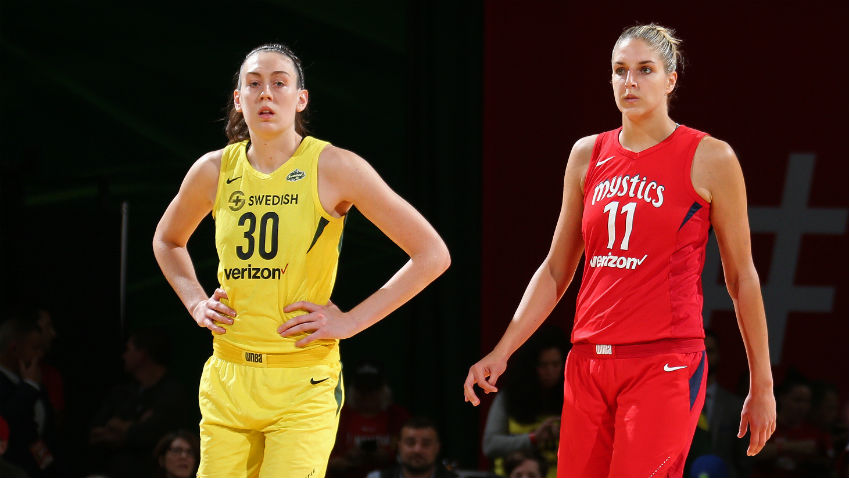Inside The W with Michelle Smith

It started as historic. It ended as extraordinary.
The 20th season in WNBA history was supposed to be a tribute to longevity and perseverance. It ended up being so much more:
Introductions. The WNBA has seen an influx of young talent every year, and the league’s latest prized No. 1 pick, Breanna Stewart, continued the streak of impressive rookie campaigns. Already perhaps the most decorated player in women’s college basketball history, Stewie picked up where she left off in her pro debut with the Seattle Storm. Flanked by veteran point guard Sue Bird and fellow young gun Jewell Loyd, she has the Storm well set up for the future.
Meanwhile, in San Antonio, Stewart’s college teammate Moriah Jefferson made the best of a tough situation for the Stars by leading her team in scoring and assists. And elsewhere, in Indiana, Tiffany Mitchell, the South Carolina product, settled into her role with the Fever — a role that’s liable to grow with the retirement of Tamika Catchings.
Farewells. Some of the most relevant, productive and influential talents in the history of the WNBA said goodbye at the end of this season. Tamika Catchings means as much to the WNBA as any individual player ever has and the end of her storied career was bittersweet to say the least. To list all of Catch’s statistical accomplishments would overshadow the respect she has from every other player in the league or the work she’s done in the community.
Swin Cash is a leader and a champion twice over, and her graceful contributions to the league will be sorely missed, as well. Penny Taylor was more than a stalwart in Phoenix; she was one of the league’s most successful international talents, a three-time champion and a beloved teammate and colleague.
DeLisha Milton-Jones played more games than anyone in WNBA history – 499 in all – and that run officially ended with the end of the 2016 regular season.
Records. The Los Angeles Sparks tied the best start in league history, winning 20 of 21 games to open the schedule. When Los Angeles and Minnesota met on June 21, both of them were a combined 23-0, and it was the first matchup of two unbeaten teams from the WNBA, NBA, NFL, MLB or NHL with each squad having at least 10 wins. It was poetic that the game was played on the 20th anniversary of the inaugural WNBA game between New York and Los Angeles back in 1997.
When league MVP Nneka Ogwumike went 12-for-12 from the floor in a June game, she set not only a league record, but an incredibly high bar for everyone else.
Activism. In a summer of protest and social justice, the WNBA players stood out and stood up. From Minnesota to New York to Indiana to Phoenix, WNBA Players came together as colleagues and teammates and set a tone for the conversation around social injustice in America. They were trailblazers and role models. They were lightning rods and community organizers. As a collective, they made their voices heard.
Star power. Star players did what stars do: shine bright. The teams that reached the playoffs had big names and big performances. Diana Taurasi, Maya Moore, Tamika Catchings, Sue Bird, Tina Charles, Elena Delle Donne, Angel McCoughtry, Candace Parker – all played huge roles in their teams’ success this season. The teams that watched from the outside — Connecticut, Washington, Dallas and San Antonio — it could be argued, were missing that star power, the player that would power them to the next level.
Nobody’s perfect. The Phoenix Mercury were a disappointment during the regular season before reaching the semifinal round. The Dallas Wings struggled with injuries during a difficult first season in their new home city. The officiating issued corrections on missed calls in the final two games of the Finals. A late-season injury took Elena Delle Donne out of Chicago Sky’s postseason run.
A new, improved postseason? The league mostly scored with its new postseason format, which awarded playoff berths to the top eight teams regardless of conference and employed a single-game, single-elimination format for the first two rounds. The new format generated excitement around the league until the final days of the regular season and resulted in strong matchups. But the single-elimination format in the first two rounds spelled a quick season’s end to some of the league’s best players, denying the league additional showcase opportunities for its top talent. Once the playoffs hit their semifinal round, they hit their stride and resulted in a compelling postseason. Here’s one suggestion for a tweak in 2017… two single-elimination play-in games for the 5-8 seeds. A three-game series in the second round, followed by a three-game semifinal series, leading into a five-game Final.
A happy ending. The best two teams in the league — featuring star-filled rosters playing at the game’s highest levels — competed to a winner-take-call fifth game that was ultimately decided with just seconds left on the clock. What more could the WNBA possibly ask for in this historic season?
And one more thing: a storybook finish for Candace Parker, who had toiled for eight years in Los Angeles in her quest for a championship. She finally got one and her emotions — not only from winning, but from the release of pain and grief she experienced in losing her college coach Pat Summitt earlier in the season — came pouring out.
Parker’s tearful celebration was a lasting memory of the 2016 and it is a good one.
Television ratings were up, attendance improved. The Olympic break made room for another gold medal by the remarkable women of Team USA. And the WNBA turned 20.
It was unforgettable. It was extraordinary. And now it’s history.
Longtime WNBA reporter Michelle Smith will have a weekly column on WNBA.com throughout the 2016 season.
The views on this page do not necessarily reflect the views of the WNBA or its clubs.
,xPosition=.5,yPosition=.5)
,xPosition=.5,yPosition=.5)
,xPosition=.5,yPosition=.5)